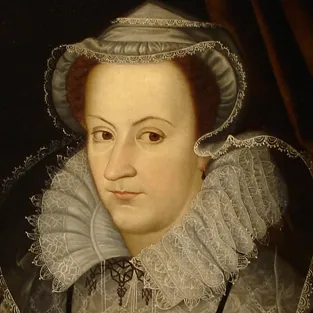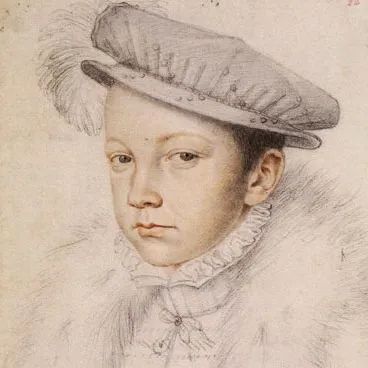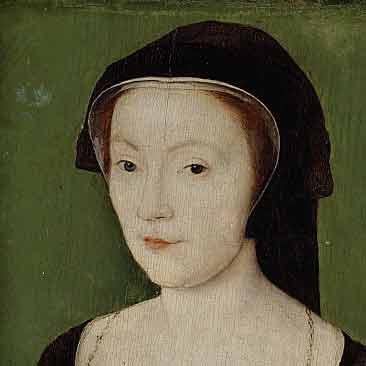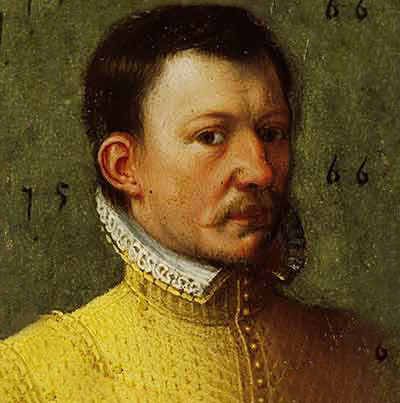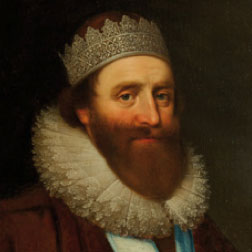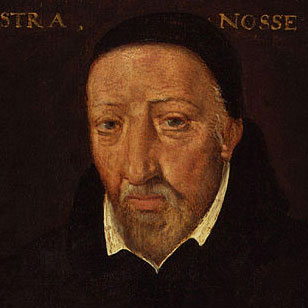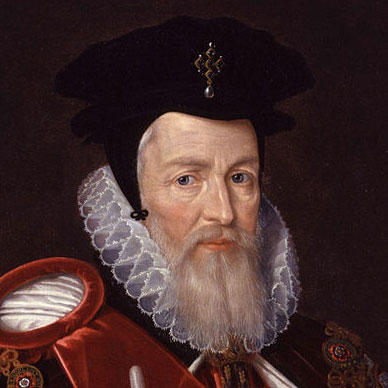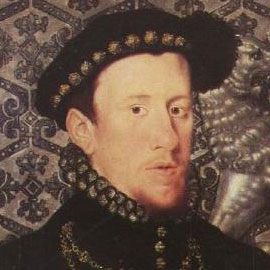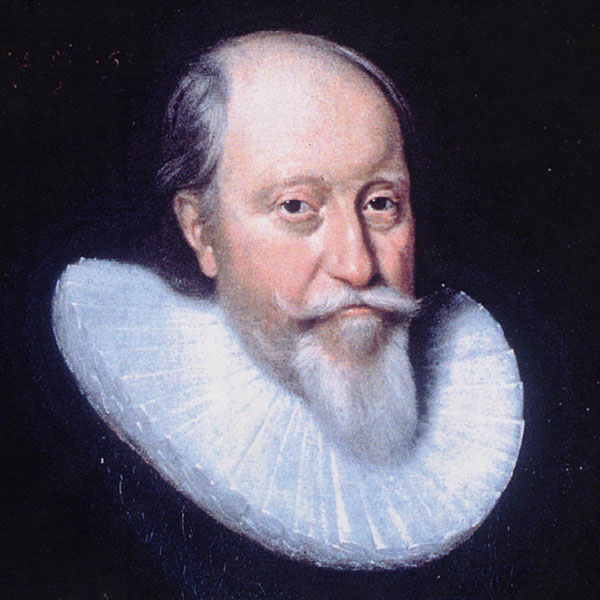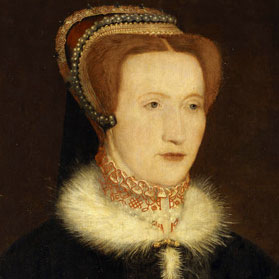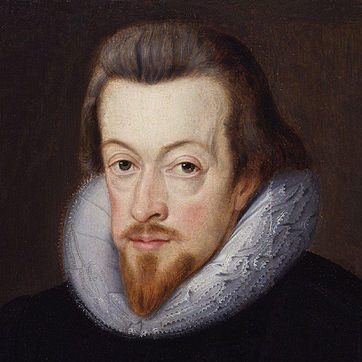Henry Stuart, Lord Darnley was the eldest son of Matthew Stuart, 4th Earl of Lennox and Lady Margaret Douglas, niece of Henry VIII. He was born on 7 December 1546, and was four years younger than Mary Queen of Scots. He and his brother Charles, nine years his junior, were the only two of the Lennoxes’ ten children to survive infancy, making it understandable that they were indulged by doting parents. He was brought up as a Catholic with every expectation of inheriting both the English and Scottish thrones. He learned all the courtly pursuits, being a capable poet, lute player and dancer. He was an excellent horseman, loving the chase and hawking, and was trained in swordplay, shooting, running at the rings, tennis, golf and pell mell (croquet).
After her marriage in 1544 Lady Margaret, as an ardent Catholic, spent most of her time until the death of Edward VI in 1553 out of sight in Yorkshire. On the accession of her close friend Mary Tudor, she returned to apartments at the Palace of Westminster, where she paraded her good-looking eldest son at Court and was recognised by the Catholic Mary Tudor as heir to the English Crown. On Mary Tudor’s death and Elizabeth’s accession, she again retired to Yorkshire, where Elizabeth’s advisers gathered evidence of her activities. When Elizabeth heard that Lennox was supporting the French party in Scotland, he was arrested and thrown into the Tower. Although Lady Margaret was able to send Darnley to France, she was confined with her other children at the home of Sir William Sackville at Sheen, where it was said that she claimed to be the rightful Queen. She was excluded from the succession based on unfounded questions over her legitimacy, but now focused her considerable skills on promoting her son, Darnley.
When, on the death in 1559 of Henry II of France in a jousting accident, Mary Queen of Scots became Queen Consort of France, Lady Margaret sent her thirteen-year-old son with his tutor John Elder to offer his condolences. Mary gave Darnley 1,000 crowns and invited him to attend Francis II’s coronation. On the death of Mary’s husband, Francis II, in the following year, the good looking fourteen-year-old was again sent to commiserate. Although Lady Margaret plied Mary with the dynastic advantages of marrying Darnley, even suggesting that they could replace Elizabeth to restore a Catholic English crown, her proposal fell on deaf ears. Mary had no desire to be confrontational with Elizabeth, who would see the marriage as hostile and was still intent on marriage to Don Carlos. In Elizabeth’s eyes, if Mary Queen of Scots were debarred for being born outside England, the next in line dynastically were Lady Margaret and her two sons, Darnley and his brother Charles. As she remained Catholic, Henry VIII had already vetoed Lady Margaret under his will, and she was equally unacceptable to the English Parliament. Yet Elizabeth had some sympathy for the Lennoxes. In February 1563, she asked Mary to end Lennox’s long exile in England to allow him to return to his Scottish estates.
With Lady Margaret still acting as a centre for Catholic intrigue, Elizabeth kept her under virtual house arrest at Court, where the seventeen-year-old Darnley sang and performed on the lute in the evenings ‘as indeed he plays very well’. Her motive for Lennox’s rehabilitation seems to have been to destabilise the Scottish Government, while Mary was continuing to negotiate her marriage to Don Carlos. Mary agreed to repatriate Lennox and, on his return, restored his estates despite her nobles’ opposition. Elizabeth had no initial intention of allowing his son to come to Scotland, but Mary recognised the dynastic advantage for her of marrying him. Although apparently Catholic he did not seem vehemently so, regularly throwing his critics off guard by attending Protestant services. This made him less threatening than Don Carlos. Although she was playing along with the suit of Elizabeth’s choice of Lord Robert Dudley, and was still secretly trying to revive negotiations to marry Don Carlos, she also wanted to meet Darnley. She sent Sir James Melville to London to encourage Lady Margaret to seek a passport for her son to visit his father.
Everyone knew what was going on. On arrival in London, Melville had to answer questions from Elizabeth on Mary’s interest in Darnley. She had already told him that ‘ye like better yon long lad’, but he replied: ‘No woman of spirit would make choice of such a man that was more like a woman than a man, for he was very lusty[1], beardless and baby-faced.’ Despite a veneer of polish, the English Court thought him reckless, proud and stupid. He was involved in every sort of sexual excess including homosexual relationships, leaving him with syphilis, although this may not have yet manifested itself.
Lady Margaret worked hard to gain Darnley’s passport, despite Elizabeth’s initial refusal. There was no time to waste as Elizabeth was still actively promoting Lord Robert Dudley. Elizabeth was uncertain how to handle Mary’s marriage and, on 23 September 1564, wrote: ‘I am at a loss to know how to satisfy her, and have no idea what to say.’ William Cecil, English Secretary of State, was aware that marriage to Darnley would make Mary’s dynastic claim to succeed Elizabeth unassailable, and it allowed Elizabeth to retain Leicester for herself. Yet he saw Darnley as being much less dangerous than a foreign prince, having personal shortcomings which would destroy Mary’s credibility. He shared the English view that if she ‘take fantasy to this new guest, then shall they be sure of mischief’. Darnley was already arrogantly parading his own dynastic claims to both the Scottish and English thrones. He was a ‘political lightweight’, insufferably spoilt by his doting parents. If Cecil wanted to overlook Mary as Elizabeth’s heir, Darnley was next in line. He was male, was born in England, and was not debarred under Henry VIII’s will. With Leicester still harbouring ambitions to marry Elizabeth, he eventually tipped the balance with Cecil to promote Darnley as Mary’s consort, and together they encouraged Elizabeth to permit his visit Scotland.
Initially, Cecil saw the effeminate Darnley as a temporary diversion for Mary to delay more serious propositions, never expecting that she would tolerate his bisexual and boorish character for long. This fitted with his tactic of masterly inactivity to delay Mary’s choice of a husband for as long as possible. He may even have persuaded the Earl of Moray that Darnley was not a real threat. He gambled that if Mary married him, Elizabeth would realise that together they were inappropriate as her successors, despite their unrivalled dynastic claim. Yet he failed to appreciate that their marriage would destroy Moray’s authority, upon which the English alliance depended. He thus did not oppose Elizabeth in granting Darnley a passport on 12 February 1565, for a short visit to his father in Scotland. Elizabeth seemed to believe that he would never agree to marry Mary with his mother held under her control and with the risk for his family of losing their substantial English estates.
Moray disagreed with Cecil, believing that the marriage would undo his considerable achievement on Mary’s behalf. He planned to kidnap the couple, but by the time he had put together a sufficient force they had left Edinburgh to go hunting. Lennox and Darnley were supported by their kinsman, Atholl, and initially in William Maitland, who saw Darnley as meeting Mary’s dynastic ambitions to gain the English throne. Moray was quicker than either Maitland or Atholl to see that Darnley would alienate them all in the end. Maitland, who was abroad, could not see his shortcomings at first hand, but he came to realise that Moray had been right. He also found that his position as Secretary of State was being usurped by David Riccio, a Catholic musician, who Darnley befriended. He may have thought that Mary would reinstate him when required, but, if so, he reckoned without her growing infatuation. It was Maitland who was the architect of the plans to murder Riccio and to remove Darnley from the throne.
On arrival in Edinburgh on 13 February 1565, Darnley made a favourable impression. As the son of handsome parents, there can be little doubt that he was exceptionally, if effeminately, good-looking with a slim athletic physique. He was about six foot two inches tall, compared to Mary, who was only about three inches shorter, and they towered above their contemporaries. Yet beneath his outward appearance, he was an objectionable and self-opinionated boor. Despite his careful education, he had no natural intelligence and lacked common sense. He was often drunk and sexually promiscuous, being openly homosexual. Thomas Randolph, the English ambassador, did not relish Darnley’s arrival, and had heard ‘bad things’ about him. These appear to have been common knowledge in England at least.
Darnley travelled on to Fife, where Mary was hunting and she was impressed on their meeting. She described him to Melville as ‘the lustiest and best proportioned long man that I have ever seen’. He went on to visit his father at Dunkeld, but returned in time to take the ferry with her over the Firth of Forth, as she returned to Holyrood. She gave no initial sign that their meeting was any more than a courtesy, but Moray saw him ‘rather as an enemy than a preferer of Christ’s true religion’. Darnley tried to allay his fears by going with him to St. Giles to hear John Knox preach, but he also attended Mass privately with Mary. He dined at Holyrood with Randolph and Moray, who suggested that he should partner Mary in a galliard. Randolph reported: “A great number wish them well – others doubt him, and deeply consider what is fit for the state of their country.” Darnley displayed his veneer of courtly skills as a musician, poet and dancer, charming Mary with his lute playing and enjoying cards and dice with her. They went hawking and hunting, but she still did not show him undue attention.
No one believed that the match would prosper. Elizabeth was never likely to countenance it, although Mary may have interpreted her granting of a passport as tacit approval. Randolph believed that her interest arose ‘rather from her own courteous nature than that anything is meant, which some here fear may ensue’. Yet he was soon admitting that Darnley’s behaviour was ‘well liked’. Darnley lost no time in proposing marriage, which Mary just as quickly turned down. As he was Catholic, she needed to prepare the ground.
When the suit to marry Leicester fizzled out, it became inevitable that Mary would marry Darnley and she sent Maitland to England for Elizabeth’s consent. This was refused with a claim that she took offence at Darnley’s failure to seek her permission before leaving England. With Darnley’s gloss of charm starting to crack, Moray started openly to oppose the marriage. He saw no prospect of retaining his former authority if Darnley became King. On 5 April 1565, the Court moved for Easter to Stirling Castle, but Darnley became ill with a measles-like rash accompanied by ‘sharp pangs, his pains holding him in his stomach and in his head’. These showed all the symptoms of secondary syphilis, which must have been contracted in England before his arrival. Mary insisted on nursing him herself and any formality between them evaporated. As he slowly recovered any pretence at Royal decorum disappeared; she was overwhelmed with feelings that she cannot have known she possessed. He was too narcissistic to become infatuated, seeing her only as a trophy. No one had bargained on the model Queen falling in love out of unbridled passion. She later claimed that Moray had encouraged the suit to annoy the Duke of Châtelherault and the Hamiltons. He certainly seemed slow in trying to stop it from developing, implying that he accepted Cecil’s assumption that she would soon realise Darnley’s shortcomings. In a letter to Cecil, Randolph belittled Darnley’s ‘behaviour, wit and judgement’, and considered Mary to be ‘in contempt of her people’.
With European heads of state sending their approval, Mary ignored Elizabeth and went ahead, but promised Moray that she would not offer Darnley the Crown Matrimonial, which would have allowed him to succeed her if she died childless. Moray withdrew from Court ‘indignant at the overwhelming insolence of Darnley’. Mary gained Government backing, although ‘many consented on condition that no change was made to the established state of religion’. She was popular and, after four years of tolerance shown to the Reformers, they did not consider it a bad match. It would not take Darnley long to undo this goodwill. He became so objectionable that even his allies could no longer find words to defend him. Although Mary tried to temper him, he remained ‘proud, disdainful and suspicious’. She remained focused on her wedding regardless of criticism. Cecil contemplated going to war, but, with Darnley being universally despised, held a perverse views that the marriage should be encouraged.
On 9 July, Mary and Darnley stayed for two nights at Seton, where it is alleged that they consummated their marriage, after a hand-fasting (betrothal ceremony) held at Holyrood. Before the wedding on 29 July, she confirmed that Darnley would henceforth be known as King Henry, but resisted his demand for the Crown Matrimonial. He wore a magnificent outfit covered in jewels for the marriage, while Mary, for the last time, wore her mourning clothes. The celebrations continued for three days, but Darnley remained objectionable, and Randolph reported that ‘he looketh now for reverence to many that have little will to give it to him’. Moray received English backing to take up arms against the couple, but, lacking Scottish support, the opposing armies never met, and he was forced into exile in England. With Mary and Darnley forming a progressively more Catholic Government, his former allies soon sided with him again.
By September, Mary was pregnant, and Darnley spent long periods away from Edinburgh with his father, ostensibly on hunting expeditions, but in practice plotting to gain Catholic support to take the Crown. He had delusions of grandeur, as there was no concerted support for him in Scotland, although his efforts on behalf of the Catholic Church were recognised abroad. On 7 February 1566 he was invested with the Order of St Michel by the French ambassador with similar praise coming from the Papacy. Mary was furious and cancelled an understanding that they ruled jointly.
Darnley was spending increasing time in the Edinburgh brothels. Mary was left on her own, and amused herself playing cards with Riccio, who was acting as her Secretary of State. Maitland hatched a plan to tell Darnley that the relationship was improper (although it certainly was not) and the nobles promised him the Crown Matrimonial if he would agree to arrange Riccio’s murder and uphold the Protestant religion. Extraordinarily Darnley agreed. Maitland’s real motive was to implicate Darnley in the murder (and by association Mary) so that Moray could be restored to authority. Both Moray and Cecil were aware of this objective. Darnley hoped to carry out the murder in Mary’s presence, in expectation that the shock would cause a miscarriage and her likely death, allowing him to gain the Crown. Yet, when Riccio was murdered, Mary coolly separated Darnley from the Earl of Morton and his other fellow conspirators and escaped with him to Dunbar with help from the Earl of Bothwell. Despite returning to Edinburgh in triumph, she could not reveal Darnley’s treasonable part in the plot, without risking her unborn child’s legitimacy, but she forced Morton and his fellow conspirators into exile. They now sought revenge against Darnley for revealing their involvement. Although he was shunned on all sides, he brazened it out, signing a declaration before the Privy Council that he had played no part in the murder. His fellow conspirators promptly sent Mary the bond approving the murder, which he had signed. He continued his Catholic plotting with foreign heads of state, hotly denying his part in any wrongdoing.
On 19 June 1566, Mary gave birth to her son, James, in Edinburgh Castle, ending any hope for Darnley to succeed to the Scottish throne, but his relationship with Mary continued to deteriorate. In an effort to achieve a reconciliation and to keep track of his plotting, she renewed sexual relations with him. He did not go with her to Jedburgh in September, when she attended an assize and became dangerously ill following an abdominal haemorrhage. Although he came to see her briefly from a hunting expedition in Ayrshire, he was not welcome and retired back west, while Mary, as she convalesced, discussed the possibility of a divorce with her senior nobles.
Divorce did not prove practicable without prejudicing James’s legitimacy, but her nobles, without consulting Mary, began to develop a plan to murder Darnley. Meanwhile Mary had arranged a sumptuous baptism for James at Stirling attended by many foreign dignitaries. Although Darnley arrived there, he was suffering an outbreak of his syphilis and could not appear. The foreign dignitaries shunned him anyway because of his part in Riccio’s murder. When the christening celebration was over, he retired to recuperate with his father in Glasgow. Mary did not dare to leave him out of sight for too long and, on 20 January 1567, she set out to persuade him to return with her to Edinburgh. He agreed to return to convalesce at Kirk o’ Field, where his disfigured face was shielded from prying eyes at Holyrood.
It was now that Bothwell took charge of the murder plan, and used his henchmen and those of other members of the nobility to blow up the lodging. Darnley must have heard a noise as he tried to escape, but, on 10 February 1567, was suffocated in a nearby Garden.
Further Reading: Was Mary Queen of Scots involved in the murder of her husband Lord Darnley?


